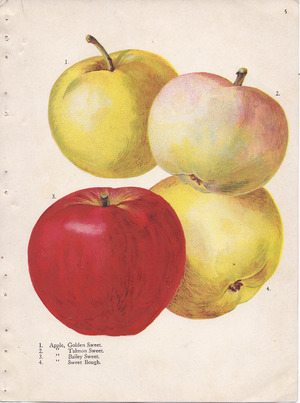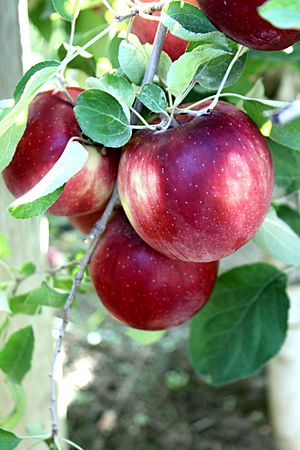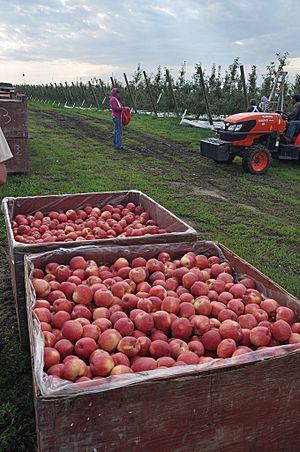EverCrisp facts for kids
Quick facts for kids MAIA-1, 'EverCrisp' |
|
|---|---|

Illustrations by Alois Lunzer depicting apple cultivars Golden Sweet, Talmon Sweet, Bailey Sweet and Sweet Bough. (1909)
|
|
| Genus | Malus |
| Species | M. pumila |
| Hybrid parentage | Honeycrisp × 'Fuji' |
| Cultivar | 'EverCrisp' |
| Origin | |
The EverCrisp apple is a special kind of apple grown in America. It was created by a group called the Midwest Apple Improvement Association (MAIA). The EverCrisp apple, also known as the MAIA-1, is a mix of two popular apples: the Honeycrisp and the Fuji.
This apple first came from Ohio in 1998. Now, you can find EverCrisp apples growing in many parts of the Midwest, like Michigan, Illinois, and Indiana. They also grow in the Northeast, in Pennsylvania and New York. People could start buying EverCrisp apples in stores in 2017.
Contents
The Story of EverCrisp Apples
How EverCrisp Apples Began
Mitch Lynd, who owns Lynd Fruit Farms in Patakasla, Ohio, started developing the MAIA-1 apple in 1998. He carefully mixed the pollen from Honeycrisp and Fuji apples in 1998. Then, the first tiny apple plants, called seedlings, started to grow in 1998 and 1999.
Mitch Lynd did a lot of work to share these new seedlings with other farmers. This allowed the MAIA-1 apple to grow and develop in the soil of the Midwest. By 2007, the first test trees began to produce fruit. These early apples were tasted and checked by experts. If they tasted good, they would be tested by more people.
In late 2008, David Doud from Countryline Orchards in Roann, Indiana, grew an MAIA-1 apple from a test tree. He called the MAIA-1 apple the "apple with the 21st century crunch." He thought it was better than any other apple he was growing! The MAIA-1 apple soon got its official name: EverCrisp. It was the first apple variety released by the MAIA group.
EverCrisp Apples Today
After nearly 20 years of work, EverCrisp apples were finally ready for everyone to buy in late October 2017. You can find them at apple farms across the Midwest and Northeast. They are also sold in grocery stores like Lunds & Byerlys and Heinen's Fine Foods, and at farmers' markets.
By October 2018, EverCrisp apples were being grown in 350 apple farms across 32 states in the United States. The MAIA group believes they have planted over 600,000 EverCrisp trees since the apple was first created.
EverCrisp is known as a "club apple" variety. This means that apple farmers who want to grow and sell EverCrisp apples need to join a special club. They have to buy a membership and get a special permission, called a license, to grow them. Bill Dodd, who is the president of the MAIA, said in 2014 that "no one will be excluded" from being able to grow EverCrisp apples.
The Midwest Apple Improvement Association (MAIA)
The Midwest Apple Improvement Association (MAIA) is an organization started by apple farmers Mitch Lynd and Ed Fackler in the mid-1990s. Even though MAIA is its own group, it gets advice from Dr. Diane Miller at Ohio State University.
The MAIA was formed because apple growers in the Midwest needed new apple types. They wanted apples that would grow well in the Midwest's climate and could be picked later in the season. About 50 apple farmers in the Midwest agreed to pay money each year to help create and grow new apple varieties on their own orchards.
In the spring of 1997, which was MAIA's first year of breeding, they developed 5,300 new apple seedlings. They did this by mixing existing apple types like GoldRush, Sweet Sixteen, Crimson Crisp, HoneyCrisp, Fuji, and Golden Delicious. The MAIA estimates that they have given out over 50,000 seedlings to their members in the last two decades.
Because EverCrisp was so successful, the MAIA released two more new apple varieties in early 2017. These were called 'Crunch-A-Bunch' and 'Bakers Delight'. These new apples, also known as MAIA-11 and MAIA-12, were made for both large apple farms and for people who just like to grow apples in their backyard.
In 2018, Bill Dodd, the president of the MAIA, guessed that 70,000 to 80,000 bushels of apples would come from the 700,000 apple trees MAIA had planted. (A bushel holds about 125 medium apples!) Dodd thinks that by 2020, one million apple trees will have been planted by the MAIA.
The MAIA wants to have different apple varieties available for the whole season. They plan to release new apples like 'Summerset', 'Rosalee', 'Sweet Zinger', and 'Ludacrisp' by 2021. In the next few years, the MAIA hopes to have early, mid-season, and late-season apples for everyone to buy. By 2019, MAIA had 700 members around the world.
Designer Apples

EverCrisp is part of a new trend called "designer fruit." These new apples are not just juicy, crunchy, and tasty. They can also be stored for a longer time and are better at fighting off diseases. EverCrisp, along with other successful designer apples like Cosmic Crisp, SweeTango, and Zestar, are part of this new group of apples. They are "more delicious, beautiful, convenient for eaters and more productive for growers."
People want better quality fruits and more choices when they buy produce. This is why the market for designer apples in the U.S. is growing. Apple breeders, like those at the MAIA, are working hard to meet this demand. They are releasing new apples, each with its own special qualities. Some look better, some don't turn brown as fast, and some are crunchier, sweeter, or more tart. There's an apple for everyone!
These new designer apples might even become more popular than old favorites like Red Delicious, Granny Smith, McIntosh, and Honeycrisp. If groups like the MAIA and Washington State University keep releasing new apple varieties, older types of apples might eventually be replaced.
Marketing is also a big reason why club apples like EverCrisp and Cosmic Crisp are so successful. The names of apples can make a difference to customers. EverCrisp is marketed as the apple whose "name says it all." The EverCrisp Apple website says that EverCrisp is a "durable apple [that] maintains sweetness and firmness like no other."
Even though marketing for special, patented fruits is fairly new, it's working well for apples like Cosmic Crisp. The Cosmic Crisp apple's marketing campaign focuses a lot on what customers want. They do taste tests and focus groups to create excitement for the apple even before it's in stores. Washington State has planted over 12 million Cosmic Crisp trees to get ready for its release.
Growing EverCrisp Apples

EverCrisp is a late-season apple. This means it ripens in mid-October and is usually picked from October to November, depending on where it's grown.
On David Doud's farm in north-central Indiana, EverCrisp apples are ready to pick between October 10 and October 15. Doud says that EverCrisp can be picked easily for three weekends in October. In northern Indiana, if EverCrisp apples are left on the tree until November, they might get a problem called watercore.
Mitch Lynd, one of the founders of MAIA, says that EverCrisp is "more grower friendly" than the Fuji apple. This means it's easier for farmers to grow. He joked that Fuji apples grow "a lot of tree and not a lot of apples." But EverCrisp trees make "a lot of apples but not a lot of tree."
What EverCrisp Apples Look and Taste Like
The EverCrisp apple is known for being sweet, crisp, firm, and dense. It gets these qualities from its parent apple, the Honeycrisp. Jeff Cady, who works for Tops Friendly Markets, says EverCrisp has a strong Honeycrisp flavor with a distinct Fuji-like tang.
People who tasted EverCrisp for Bloomberg said it had an "in-your-face candied-apple sweetness." They also noted a background tang and a "monstrous crunch."
The EverCrisp apple has a "blushed rosey red over a cream background." While its texture is like a Honeycrisp, its outside shape looks most like a Fuji apple. The MAIA says EverCrisp has a "slightly harder" skin than Honeycrisp.
Dave Rennhack of Rannhack Orchards Market said that EverCrisp apples store very well. He noted that "The apple eats even better after two or three months in the cooler." He also said that the flavor becomes a bit milder, and the color changes from a green tint to a "pineapple gold," making the apple look very appealing. Bill Dodd, president of the MAIA, said EverCrisp can be stored as well as a Fuji, and it keeps its crunch like a Honeycrisp. He mentioned that "EverCrisp can last on the counter for two weeks where the Honeycrisp will start losing quality."

